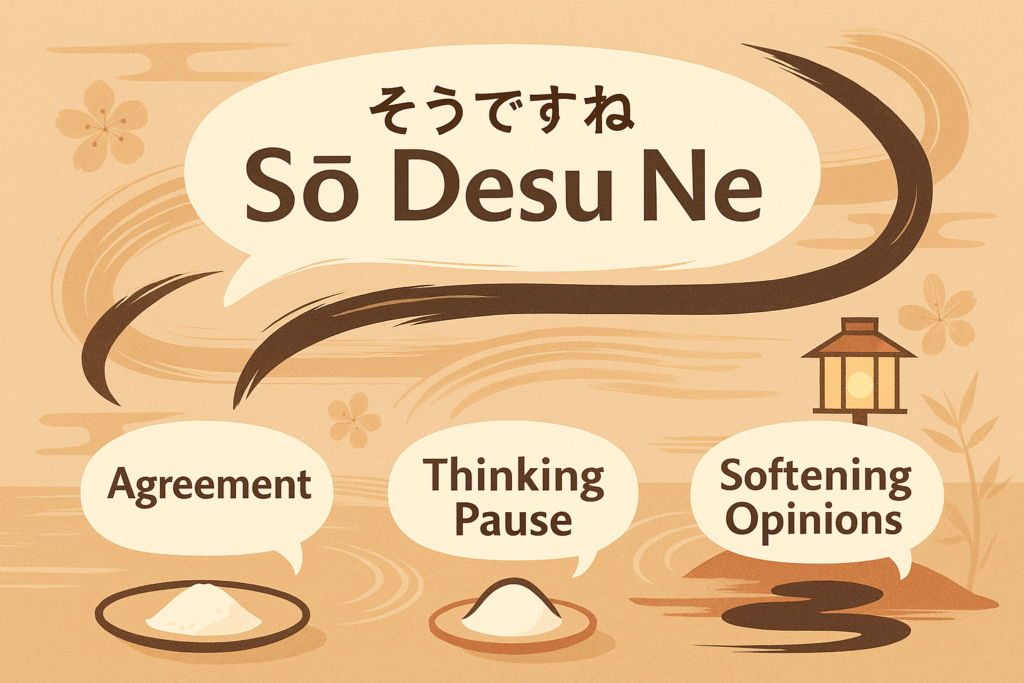Have you ever noticed how Japanese conversations flow with a rhythm of nods, expressions, and those little phrases that seem to keep everything moving smoothly? If you’ve watched anime, Japanese dramas, or spent any time with native speakers, you’ve likely heard “so desu ne” repeated countless times. This deceptively simple phrase is one of the most frequently used expressions in everyday Japanese conversation—but its meaning and usage are far more nuanced than most language learners initially realize.
Understanding the so desu ne meaning can transform your Japanese from textbook rigid to naturally conversational. This powerful little phrase helps you sound more like a native speaker while strengthening your connections in Japanese social settings. Let’s explore why mastering “so desu ne” is essential for anyone serious about Japanese fluency.
What Does “So Desu Ne” Mean?
At its most basic level, “so desu ne” (そうですね) translates to “that’s right, isn’t it?” or “yes, that’s so.” Breaking down its components:
- So (そう) – means “that way” or “like that”
- Desu (です) – is the polite form of “to be”
- Ne (ね) – is a particle that seeks agreement or confirmation, similar to “isn’t it?” or “right?”
However, the true so desu ne meaning extends far beyond this literal translation. This versatile phrase functions as an agreement marker, a thinking pause, a conversation softener, and much more depending on context and delivery.
Unlike its question-oriented cousin “so desu ka” (which expresses inquiry), “so desu ne” generally signals agreement or acknowledgment while inviting continued conversation. It’s the verbal equivalent of a thoughtful nod that says, “I’m with you, please continue.”
The Many Uses of “So Desu Ne” in Japanese Conversation
1. Expressing Agreement
The most straightforward so desu ne meaning is agreement with what someone has said.
Example: Friend: “Kyō wa totemo atsui desu.” (Today is very hot.) You: “Sō desu ne. Mō natsu mitai desu.” (That’s right, isn’t it. It’s already like summer.)
2. Creating a Thinking Pause
Japanese speakers often use “so desu ne” while gathering their thoughts—similar to saying “well…” or “let me see…” in English.
Example: Someone asking for advice: “Dono resutoran ga ii to omoimasu ka?” (Which restaurant do you think is good?) You: “Sō desu ne… Tanaka-san wa tabemono ga oishii tokoro ga suki desu.” (Let me think… Tanaka-san likes places with delicious food.)
3. Softening Opinions or Disagreements
“So desu ne” can gently introduce a different perspective without creating direct confrontation.
Example: Colleague: “Kono purojekuto wa raishū made ni owarimasu.” (This project will finish by next week.) You: “Sō desu ne. Demo, mō sukoshi jikan ga hitsuyō kamoshiremasen.” (Yes, that’s true. But, we might need a little more time.)
4. Acknowledging Without Full Commitment
Sometimes, “so desu ne” serves as polite acknowledgment without fully agreeing—particularly useful in business settings.
Example: Business partner: “Kono keikaku wa kanpeki desu.” (This plan is perfect.) You: “Sō desu ne. Sukoshi kenshō shimashō.” (I see what you mean. Let’s verify a few things.)
Want to explore Japan’s culture?
Discover Japan’s rich culture, traditions, and hidden gems with our expertly crafted guides. Get insider tips on travel, food, and history. All for free!
“So Desu Ne” Variations and Formality Levels
Like many Japanese expressions, “so desu ne” exists on a spectrum of formality. Understanding these variations is crucial for appropriate usage:
| Expression | Formality | Context |
|---|---|---|
| Sō desu ne (そうですね) | Formal/Polite | Standard polite form, suitable for most situations |
| Sō da ne (そうだね) | Casual | Among friends, family, people of equal status |
| Sō ne (そうね) | Very casual | Primarily used by women in familiar settings |
| Sō sō (そうそう) | Very casual | Emphatic agreement in close relationships |
Similar to how we explored the nuances of “arigato gozaimashita”, these variations reflect the importance of social hierarchy in Japanese communication.
Common Mistakes When Using “So Desu Ne”
Mistake #1: Confusing “So Desu Ne” with “So Desu Ka”
While similar sounding, these phrases serve different functions. “So desu ka” questions or expresses surprise, while “so desu ne” confirms or acknowledges.
Better approach: Remember that “ka” questions while “ne” confirms.
Mistake #2: Using It When You Actually Disagree
Using “so desu ne” and then contradicting yourself can come across as confusing or insincere.
Better approach: For disagreement, try phrases like “sō desu ga…” (that’s true, but…) instead.
Mistake #3: Overusing in Professional Settings
While “so desu ne” is polite, overusing it can make you seem indecisive or lacking your own opinions.
Better approach: Mix with other acknowledgment phrases like “naruhodo” (I see) or “tashika ni” (certainly).
How to Pronounce “So Desu Ne” Naturally
The intonation of “so desu ne” significantly affects its perceived meaning, similar to what we explored in our article on Japanese pitch accent:
- For agreement: Slightly rising intonation with emphasis on “ne”
- For thinking pause: Extended “soooo desu ne” with a flat intonation
- For partial agreement: Flat intonation without emphasis
Native speakers often modify the length of syllables to convey different nuances. When thinking, they might stretch the “sō” part: “Sōōō desu ne…”
Cultural Context: Why “So Desu Ne” Matters
The frequency of “so desu ne” in Japanese conversation reflects deeper cultural values:
- Maintaining harmony (和 – wa) by showing attentiveness and agreement
- Building consensus rather than asserting individual opinions
- Acknowledging the speaker before adding your own thoughts
- Creating comfortable silence during contemplation
When dealing with complex cultural situations, like meeting a Japanese father-in-law, appropriate use of phrases like “so desu ne” demonstrates cultural sensitivity and respect for social harmony.
Practical Situations to Use “So Desu Ne”
In Casual Conversations
“So desu ne” helps maintain friendly conversation flow while showing active listening.
Example: Friend: “Kono eiga wa omoshiroi desu.” (This movie is interesting.) You: “Sō desu ne. Watashi mo tanoshimimashita.” (Yes, it is. I enjoyed it too.)
In Business Settings
The phrase demonstrates thoughtful consideration before responding to colleagues or superiors.
Example: Boss: “Kono houkoku-sho wa ii desu.” (This report is good.) You: “Sō desu ne. Arigato gozaimasu.” (Yes, that’s right. Thank you very much.)
When Discussing Seasonal Topics
Similar to how we use seasonal expressions like Christmas greetings in Japanese, “so desu ne” pairs well with seasonal observations:
Example: Neighbor: “Sakura ga kirei desu ne.” (The cherry blossoms are beautiful, aren’t they?) You: “Sō desu ne. Kotoshi wa hayaku saita desu.” (Yes, they are. They bloomed early this year.)
Q&A: Common Questions About “So Desu Ne”
What is the difference between “so desu ne” and “so desu ka”?
“So desu ne” expresses agreement or confirmation and typically translates to “that’s right, isn’t it?” while “so desu ka” is a question meaning “is that so?” or expresses surprise. “Ne” seeks agreement while “ka” seeks information.
Is “so desu ne” formal or casual?
“So desu ne” is the standard polite form suitable for most situations. For more casual settings with friends, “so da ne” is appropriate, while in very formal business contexts, you might use more elaborate expressions of agreement.
Can “so desu ne” be used sarcastically?
Yes, with specific intonation (usually flat with slightly extended “ne”), “so desu ne” can express polite skepticism or disagreement. However, as a language learner, it’s best to master the straightforward usage first before attempting nuanced, potentially confusing tones.
How often can I use “so desu ne” in a conversation?
While it’s commonly used, overusing “so desu ne” can make you sound monotonous or insincere. Mix it with other response expressions like “naruhodo” (I see) or “tashika ni” (certainly) for more natural conversation flow.
Beyond “So Desu Ne”: Building Your Conversational Japanese Skills
Understanding the so desu ne meaning is just one step toward natural-sounding Japanese. To develop your conversational skills further, explore our other guides on Japanese expressions like how to use “chigau” for disagreement or what “domo” means in different contexts.
For comprehensive Japanese language resources, including vocabulary for specific topics like saying “bee” in Japanese or the word for “ice”, visit our Learn Japanese page for free guides that will accelerate your language journey.
Remember that truly mastering conversational Japanese requires practice with native speakers who can help you understand the subtle nuances of expressions like “so desu ne” in various social contexts.
So desu ne is a versatile Japanese phrase that means “that’s right, isn’t it?” and is used primarily to express agreement, acknowledgment, or create a thinking pause in conversation.
Love Japan? Stay in the Loop!
Get the best of Japan straight to your inbox: language, culture & travel insights!




